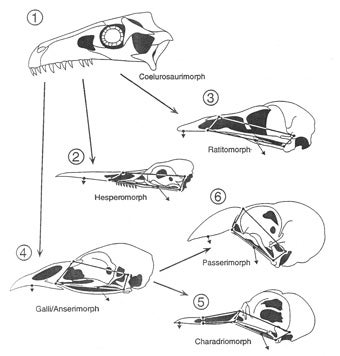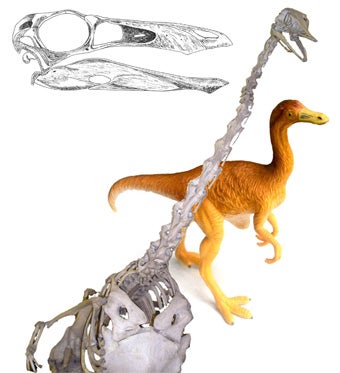This article was published in Scientific American’s former blog network and reflects the views of the author, not necessarily those of Scientific American
For years now it has been widely thought that dinosaurs all but perished in a mass extinction event that occurred about 66 million years ago, at the very end of the Cretaceous. But a single lineage – that leading to modern birds – persisted. This view is textbook dogma. It was once put forward by Thomas Huxley, and he once made a mistake about something (Feduccia 2012). But – oh ho ho! – there’s just one problem…. it’s totally wrong.

Part of the Zweers et al. (1997) model of avian polyphyly. They were right! Credit: Zweers et al. 1997
Yes, as revealed in yada yada yada new paper a team of researchers have looked at a crapton of new data (Slamdunk et al. 2017). There never was an extinction: it turns out that dinosaurs of many, many kinds persisted and survive today. The cryptozoologists were right. Previous studies were simply not extensive enough as goes character inclusion, even the best including a mere 2604 character states. You need five times that many, six times, seven times.
On supporting science journalism
If you're enjoying this article, consider supporting our award-winning journalism by subscribing. By purchasing a subscription you are helping to ensure the future of impactful stories about the discoveries and ideas shaping our world today.
As usual with such revisions, the model proposed here is not wholly novel. Why, Zweers et al. (1997) also argued that birds evolved a bunch of times from different coelurosaurian theropods. Yeah – really, I know, right?!

Ostriches really are ornithomimosaurs -- it all makes sense, right? Credit: Darren Naish
What sort of data do Slamdunk et al. (2017) pull in.. I mean, compile, amass to support their.. their stuff? We just haven’t been looking at dinosaurs in the right way. Check. It. Out. Spinosaurs and shoebills are united by a hook-like premaxillary extremity, while trenchant pedal… err, extremities unite paravian maniraptorans and raptors (not to be confused with raptors, generally termed raptors these days), the great hadrosaurian dynasty lives on in the form of geese, ratites are ornithomimosaurs, woodpeckers are scansoriopterygids… I’m sure I don’t need to continue.

Small section of the compelling stratophenetic chart from Slamdunk et al. (2017). The large size of the anserohadromorpheaeoaen icon is commensurate with the high score given to this lineage in the paper. Hassle me on social media if you want a higher-res version. Credit: Slamdunk et al. 2017
Many of these conclusions are self evident when you know birds. Who has not been in close proximity to a Moluccan cockatoo and not seen the glint of Triceratops in its eye… who, pray tell, has heard the shrill call of a Red-tailed hawk and not imagined the monstrously loud, blasting atomised spittle at the camera so loud it makes the animal’s tissues vibrate I mean like a million lions OH MY GOD IT’S SO LOUD earth shattering roar of the Tyrannosaurus rex, king of beasts, the most goddam awesome animal that has ever existed my god it’s so loud… and which of us has not looked at a Puerto Rican lizard cuckoo and not immediately been struck with the whole nqwebasaurusishness of it? None of us. I mean… all of us, whatever. But but turkeys; chickens. I rest my case (Sanchez & Smith 2013).
What does this view mean for our view of the supposedly devastating KPg extinction event? HA. It means, idiots, that, in a vast conspiracy of fear-mongering and citation pay-for-play gerrymandering, experts have over-hyped what was actually a fairly normal Tuesday afternoon in the Cretaceous, a time when a few lineages happened to squeak out of existence while the majority continued on their merry way. All to sell more textbooks, to keep those turn-stiles merrily tick-tick-ticking away at the museum entrances, to sell more toys. The money. ALL THE MONEY.
Refs - -
Feduccia, A. 2012. Riddle of the Feathered Dragons: Hidden Birds of China. Yale University Press, New Haven.
Sanchez, R. & Smith, M. 2013. “Out of the frying pan dot dot dot, right Morty?” Yeah, I was totally watching Rick & Morty when I wrote this. The whole of season 1. Bean Counter Research 4, 231-255.
Slamdunk, A., Maximus, L., Unicorn, A. & Schlong, D. 2017. Mass survival of multitudinous dinosaur lineages across the KPg Boundary. Nurture 898, 1562-1563.
Zweers, G. A., Vanden Berge, J. C. & Berkhoudt, H. 1997. Evolutionary patterns of avian trophic diversification. Zoology 100, 205-238.